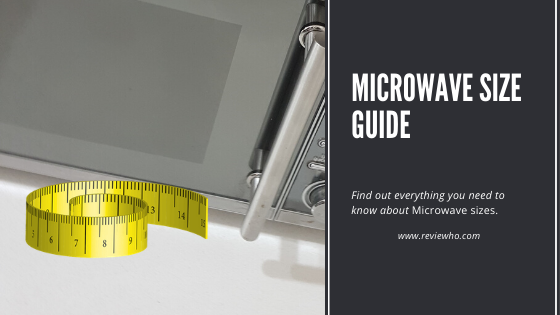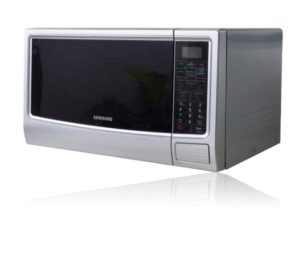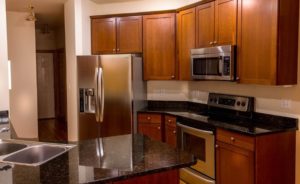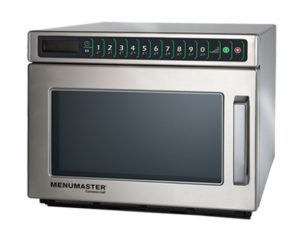Anyone who has ever tried to go out and buy a microwave knows that the proposition is not as simple as it sounds. Across the market, many different types of microwaves come in a wide range of sizes and dimensions. The question is, what type of microwave is best for me?
As a general rule of thumb, the bigger the microwave is, the more powerful it is, but the more expensive it tends to be. However, within all types and microwave sizes, there are cheaper models and more expensive models, basic models, and premium models, so while this general microwave size guide is helpful, you still need to research individual units.
When researching microwaves or any other kitchen appliance, there are several different factors to consider. Your budget, the size of your kitchen, the number of people in your house, how often you use the microwave, and what you plan to cook in it are all important in determining the microwave oven size and microwave oven dimensions that are best for you.
Luckily, this helpful microwave size guide and size comparison chart break down all the common types of microwaves and their corresponding size and dimensions, cooking capacities, cooking power, prices, features, advantages, and disadvantages.
Microwave Oven Size Chart, Watts, And Weight
| Height(in) | Width(in) | Depth(in) | Volume Cu. ft. | Watts | Weight(lbs) | |
|---|---|---|---|---|---|---|
| Small Countertop | 10-14 | 15-19 | 10-14 | 0.5-0.9 | 700-1000 | 20-30 |
| Medium Countertop | 12-15 | 20-24 | 12-17 | 1.1-1.6 | 900-1300 | 30-50 |
| Large Countertop | 15-18 | 26-30 | 15-20 | 1.7-2.2 | 1000-1400 | 50-70 |
| Over The Range | 16-18 | 24-30 | 15-18 | 1.1-2.1 | 1000-1200 | 50-65 |
| Built-in | 13-30 | 28-30 | 16-25 | 1.4-2.2 | 950-1920 | 50-100 |
| RV | 10-15 | 18-25 | 10-14 | 0.5-1.5 | Lower than 1000 | 30-70 |
| Commercial | 12-20 | 16-26 | 16-24 | 0.5-1.6 | Up to 3000 | 40-170 |
-
Countertop Microwaves: Small / Dorm Room
As the name would imply, these are the smallest type of microwaves. Being the smallest, these units are best suited for dorm rooms and small apartments. The small microwave oven size makes them light, easy to transport, and convenient in that they don’t take up much space in the kitchen. Conveniently, these are also the most affordable of all microwave sizes.
Unfortunately, they also sacrifice some of the cooking power, capacity, and functionality. Given these factors, these microwaves are best suited for cooking basics like popcorn, frozen veggies, instant rice, leftovers, and tea. Despite their limits, these small microwaves are incredibly convenient and make an excellent choice for small kitchens.
Small Countertop Microwave Average Size and Dimensions
The average external microwave dimensions of a small countertop microwave are about 15-19 inches wide, 10-14 inches in height, and 10-14 inches deep.
Cooking Capacity
Cooking capacity, or internal microwave oven size, is measured in cubic feet and it determines what can actually fit inside the microwave. On small microwaves, the capacity is anything under 1 cubic foot, with the most common size being 0.9 cubic feet. Although, some units can be as small as 0.5 cubic feet.
Watts
Watts is the measure of energy or cooking power, a microwave uses to heat food. As a rule, the lower the wattage, the longer the food will take to heat up, and the less evenly it will cook. Small microwaves typically run somewhere from 600-1100 watts, with the most common value being from 700-1000 watts.
Weight
Countertop microwaves are often lighter than other types of microwaves such as built-in or over-the-range models because they are built for portability, The average weight of small/dorm microwaves is 20-30 lbs.
Price
Small countertop microwaves are the most affordable of all microwave sizes. Prices range from $60 on the low end to $300 for small microwaves with more features. Most commonly, a small countertop microwave is around $80.
Features
Most small microwaves feature a glass turntable that rotates food and allows for even cooking. Other basic functions like timers, a defrost setting, and some pre-configured buttons to cook common foods like pizza or popcorn may be included.
Advantages
- + Cheapest of any microwave size
- + Light and don’t take up much counter space
- + Low wattage means low operating costs
- + The small interior makes it easy to clean
- + Easy to move and transport.
Disadvantages
- – Foods take longer to heat up
- – Small interior space limits the foods you can cook in them
- – Not as many features as larger units.
Best Small Countertop Microwave Models:
- Panasonic NE-1025F Compact Light-Duty Countertop Commercial Microwave
- Toshiba EM925A5A-BS Microwave Oven
- Hamilton Beach 0.7 Cubic Foot
- Insignia 0.9 Cu. Ft. Compact Microwave
-
Medium Countertop Microwaves
Medium-sized countertop microwaves are a big step up in terms of cooking capacity, power, and features from small countertop microwaves. Models of this size represent a good balance; they can have all the same features as larger units but can still be found at a more convenient size and cost.
Not only that, but they can heat up all the basic microwave foods as well as take on larger projects like defrosting a whole chicken or heating a tray of lasagna. Simply put, a medium microwave oven size is the best value of any size. These microwaves are well suited for larger apartments and homes with 3-5 people. Fortunately, this is the most common size of a microwave oven, so you have the most options in this range.
Average Microwave Size and Dimensions in Inches
The typical external microwave oven dimensions for a medium-sized countertop microwave are 24 inches wide, 14 inches tall, and 16 inches deep.
Cooking Capacity
Medium-sized countertop microwaves range from 1 to 2 cubic feet of interior cooking capacity, with 1.6 cubic inches being the most customary capacity. For most families, this is more than enough space to cook virtually all microwaved foods.
Watts
Ordinarily, medium-sized countertop microwaves cook with between 800 and 1300 watts, most commonly, they use 1000 or 1100 watts.
Weight
The average weight of medium countertop microwaves is 30-50 lbs.
Price
Depending on the included features, the price for these microwaves can vary greatly. The cheapest, most basic models can be as low as $60, whereas the most expensive medium-sized microwaves with all the added features run as high as $800.
Generally, for a family of 3-5 people, spending $100-$200 on a medium-sized microwave will get you a quality, reliable unit with more than enough space, cooking power, and added features.
Features
As with the price, the added features of medium-sized microwaves can differ greatly. There are some very basic units with the same features as small microwaves. But the good news is that many affordable medium-sized countertop microwaves have great features such as an auto-weight function for defrosting, a grill setting, convection cooking, easy-to-clean interiors, and pre-programmed sensors for popular foods.
Even better, some medium-sized microwaves have inverter cooking technology, which uses an inverter to cook rather than a magnetic coil, making microwaving faster and more energy-efficient.
Related: Everything you need to know about convection microwave ovens
Advantages
- + The perfect size and power to fit most families
- + Heats up food quickly and evenly
- + Most models are affordable but are still of high quality, providing excellent quality
- + Many useful added features and tend to be very user-friendly
- + Being the most popular size, there are more options for medium-sized microwaves than any other microwave size.
Cons
- – They may take slightly longer to cook some foods than larger models
- – These models may not be suitable for very large families.
Best Medium Countertop Microwave Models:
- General GEW1000E
- LG NeoChef LMC1275SB
- Panasonic Prestige NNSD681S
- GE – 1.1 Cu. Ft. Mid-Size Microwave
-
Large Countertop Microwaves
Predictably, large countertop microwaves have the most cooking capacity and the most cooking power of any countertop microwave. You know what that means, large countertop microwaves cook foods faster and more evenly than their smaller cousins.
These large microwaves also allow you to cook foods of almost any size and are particularly well-suited for cooking foods for long periods. Additionally, they are strong, durable machines that should stand the test of time. For bigger families, large countertop microwaves offer the best of the best in microwave cooking.
However, with that quality comes a corresponding increase in price, operating cost, and counter footprint.
Large Microwave Average Size and Dimensions in Inches
Typically, the external microwave dimensions of large countertop microwaves measure about 35 inches in height, 18-24 inches wide, and 18 inches deep.
Cooking Capacity
The cooking capacities of large countertop microwaves are anything over 2 cubic feet, with 2.2 cubic feet being the most common size. Best of all, this large microwave size allows you to use even the largest of bowls, plates, containers, and platters. You could even defrost a whole chicken, duck, or small turkey in a large countertop microwave.
Watts
These large microwaves cook with a range of 1200 to 1400 watts, 1250 watts being the most popular.
Weight
The average weight of large countertop microwaves is 50-70 lbs.
Price
Commonly, these are the most expensive countertop microwaves. There are some models on the more affordable side, but you can usually expect to pay $150-$300 for a decent large countertop microwave.
Features
Large countertop microwaves have many of the same features as medium-sized microwaves including automatic adjustment of cooking times and power levels, a grill function, auto defrost, convection cooking, inverter cooking technology, and 10 or more cooking pre-sets for most popular microwaved foods.
Advantages
- + Given the high wattage, foods will cook fastest in these units
- + It can hold larger foods that smaller models cannot
- + It can easily cook foods for longer periods of time.
Cons
- – Tend to be the most expensive of all countertop models
- – It can take up a lot of space on your countertop
- – Run higher in energy costs than smaller microwaves
- – It’s harder to find large microwaves as manufacturers produce fewer of them.
Best Large Countertop Microwave Models:
- Panasonic Microwave Oven NN-SN936B
- Panasonic Countertop NN-SD975S
- Panasonic NN-SN966S Countertop Microwave Review
- LG – 2.0 Cu. Ft. Family-Size
-
Over-the-Range Microwaves
Are over-the-range microwaves all the same size? Over-the-range microwaves are fundamentally different from any of the microwave ovens listed above as they are not set on a countertop and plugged in somewhere, they are actually professionally installed into a cabinet space above your range.
Their biggest appeal is that they save counter space and create a chic look in your kitchen. They also come with a vent system (to replace traditional kitchen hoods) and lights on the bottom to illuminate the range. Of course, before deciding on getting an over-the-range microwave, it is important to consider whether you have adequate cabinet space to accommodate one.
Generally, these microwaves are very similar in size, capacity, and features to medium-sized countertop microwaves.
However, as the microwave needs to fit into a cabinet space, all of its aspects can differ depending on the size of that space. So, be sure to do careful research and measure your space before choosing a unit.
Over The Range Microwave Average Size and Dimensions in Inches
The typical external microwave dimensions of an over-the-range microwave are 30 inches wide, 15 inches tall, and 16 inches deep, although they can vary as they need to fit into specific cabinet spaces.
Cooking Capacity
As with the size, the cooking capacity of these models can vary greatly. Depending on the size of the cabinet, the internal microwave size of these units can range from less than 1 cubic foot to over 2 cubic feet of cooking capacity, so it is important to properly measure your cabinet space.
Watts
Due to the variation in size and capacity, the wattage can also differ greatly. You can find over-the-range units from 600 watts up to 1200 watts, so there are many options to fit your desire.
Weight
Unlike countertop microwave models, over-the-range units are built into your kitchen and attached to your stovetop, the average weight is 50-65 lbs.
Price
Given that the power, size, and capacity of over-the-range microwaves all have wide ranges, so does the price. They can be found for as little as $200 and as much as $1,200. Keep in mind that you will probably need to pay $100-$150 for professional installation.
Features
Over the range, microwaves have features that align closely with those of medium and large-sized countertop microwaves. Some commonly included features are several pre-configured settings for popular foods, an auto-weight function for defrosting, and convection cooking, a grill function, and inverter cooking technology. Of course, one of the most welcome features is that these units are self-ventilating.
Suggested read: Best Convection Microwave Over The Range Reviews
Advantages
- + Save space on the counter or island
- + Incorporated fans eliminate the need for a hood system
- + Being up high, it is easy to prevent children from using them accidentally.
Disadvantages
- – It can be hard for shorter people to use and it can be difficult to pull hot liquids out of them
- – It is hard to see your food while it’s cooking
- – Requires professional installation, you cannot take them with you if you move.
Best Over-the-Range Microwave Models:
- GE – Profile Series 1.7 cu. ft. Convection
- Magic Chef 1.6 cu. ft.
- Whirlpool – 1.7 Cu. Ft.
- Samsung – 2.1 Cu. Ft. Fingerprint Resistant
-
Built-in/Drawer Microwaves
Of course, the other type of microwave that is built into the kitchen instead of being set on a counter is the built-in microwave drawer. Microwave drawers represent the most sophisticated and luxurious home microwave ovens.
By being built into the cabinets, they save valuable counter space and beautifully integrate into your cabinet space to create an elegant, modern look in your kitchen. Furthermore, they are also convenient and easy to use and can be the safest type of microwave for children, shorter people, and older people.
However, they can also be very expensive and do not always have the best features of some medium and large countertop units. Keep in mind that a built-in microwave is an investment in your kitchen that requires careful research and planning; they often do not easily fit into any cabinet.
Since built-in units are required to fit into a specific drawer space, they can be found in many different sizes with many different levels of power.
Built-in/Drawer Microwave Average Size and Dimensions in Inches
The external microwave dimensions of built-in microwaves may differ depending on the size of the drawer space. But as a general rule, microwave drawers tend to be deeper than over-the-range or countertop units. The typical dimensions for a microwave drawer would be 30 inches wide, 15 inches high, and 26 inches deep.
Cooking Capacity
Although you may be able to find some units with a larger capacity, microwave drawers most often have between 1 and 2 cubic feet of cooking capacity.
Watts
Microwave drawers usually cook with a wattage of between 800 and 1,000 watts.
Weight
The average weight of built-in microwaves is 50-100 lbs.
Price
Due to the complicated nature of fitting a microwave drawer, they are the most expensive home microwaves. Ordinarily, they will run between $700 and $1,000, plus the cost of an electrician coming to install.
Features
Features of microwave drawers include pre-configured settings for popular microwave foods, many different power settings, a child-safe mode, LED lights in the interior, easy-to-clean interiors, auto defrost mode, melt/soften/keep warm modes, and one-touch open and close functions.
Also, read:
Advantages
- + People don’t have to reach above them to take food in and out, making these microwaves safer
- + It can be programmed to be child-proof
- + It creates a sleek, elegant look in the kitchen
- + Saves countertop space.
Disadvantages
- – There is no turntable function, meaning foods may not heat as evenly
- – Requires professional installation, cannot take them with you if you move
- – Lacks convection cooking, grill functions, and inverted cooking
- – The most expensive of home microwaves.
Best Microwave Drawer Models:
- Sharp SMD2470AS
- Sharp SMD3070AS
- Bosch HMD8451UC
- KitchenAid – 1.4 Cu. Ft
- Frigidaire – Gallery 2.2 Cu. Ft
-
RV Microwave Oven
An oven is very useful when you want to heat food such as gummy pizza, hot chocolate, or even lifeless eggs. When used in the right manner, you can do almost anything you want with a microwave. Additionally, it does things faster. So, when you are in your RV, after spending the day exploring or hiking, you simply have to get warm whatever you need and you are good to go.
We all know that an RV microwave has limited space. For that reason, it is important to think carefully about the microwave you want and its ability to fit in with everything else considering the space available. Let’s look at RV microwave ovens.
Average Microwave Size and Dimensions in Inches
You can get a range of microwaves for your RV. On average, RV microwaves will fall under widths of around 23 inches, heights of around 15 inches, and depths of around 14 inches. That is the average size even though they can go higher or lower than that.
Capacity
As for the capacity, there are smaller ones that usually have a capacity of 0.5 cubic ft. You can also get larger ones with a capacity of around 1.5 cubic ft. Most of the ones in the market, however, will have around 1.0 Cubic ft.
Power
The electricity in an RV is low and limited. Therefore, you will require a microwave oven that will not drain all the power on the RV. It should be able to operate and allow the remaining appliances and features on the RV to operate too.
You will find that most RV microwave ovens are lower than 1000 watts. You can, however, find some larger ones that use more than that.
Can you use regular microwaves instead of the RV microwave? It is possible to use a regular one in an RV. However, to avoid any complications, we recommend that you get one that is almost the same as the RV microwave you had.
Weight
You will find that most of the RV microwave ovens on the market are compact. That is a specification mainly meant to help save more space on the RV.
Since they are relatively small, they are very light. You can easily move around with an RV microwave oven.
Price
You should realize that RV microwave ovens are more expensive than standard ones. That is mainly because of the installation requirements and great features. However, you will still find some that will not leave you broke.
You can spend anything as low as $100 to more than $500.
Features
The features of an RV microwave can differ based on the price and the brand. You can expect to find some unique features such as one-touch settings for cooking specific foods like Pizza, Frozen Dinner, Baked Potatoes, Popcorn, and many more.
The microwaves also have glass turntables that will rotate food and cook evenly. The door is easily accessible. Their appearances also vary greatly.
Even so, you should expect to find some great ovens with interesting features.
Advantages
- + RV microwave ovens use less power and will therefore save you energy
- + They are compact to allow for more space in your RV
- + You will find a wide range of features on RV microwaves
- + You do not require a generator to operate one
- + Modern, classy appearances.
Disadvantages
- – Their small size prevents them from cooking a lot of food at a go.
- – Heating food might take longer since they use less power.
Best RV Microwave Oven Models:
- RecPro RV Microwave
- Advent MW912BWDK Built-in Microwave
- Sharp R1874T 850W
- Greystone P90D23AP-YX-FF03
-
Commercial Microwaves
Finally, we have commercial microwaves, which are plug-in units similar to countertop microwaves. Commercial microwave ovens are very different from home microwaves in that they are significantly more powerful and more expensive, both in upfront price and operating cost.
These are heavy-duty machines built with durability in mind; they’re designed to heat high volumes of food with lightning-quick speed in commercial food service settings. Realistically, unless you are looking for a microwave for a restaurant, café, or other professional food service business, there is no need for a commercial microwave in your home.
Commercial Microwave Average Size and Dimensions in Inches
The external microwave dimensions of a typical commercial microwave oven are 18 inches wide, 14.5 inches high, and 20 inches deep. Surprisingly, commercial microwaves are often smaller than large countertop units; they are designed this way as commercial kitchens are often tight areas with a limited spare counter or shelf space.
Cooking Capacity
On commercial units, the internal microwave size usually ranges from 1 to 1.5 cubic feet. Once again, the capacity needs to be a little smaller to accommodate professional kitchens.
Watts
On the lower end, commercial units have 1,000 watts of power, but some heavy-duty models cook with up to 3,000 watts or more.
Weight
The weight of commercial microwaves is often determined by the power output, not by the dimension or capacity. For instance, a 2000-watt model weighs approximately 65 pounds. anyway, the average weight of commercial microwaves ranges from 40 to 170 pounds.
Price
Commercial microwave ovens are far more expensive than home microwaves. The price will start around $500 but can easily run as high as $3,000 or more.
Features
Commercial microwaves often do not have a large range of added features as their utility is based more on durability and cooking power than bonus functions. However, some features that are commonly found on commercial microwaves are convection cooking, automatic defrost, multiple preset cooking programs, and a bun warming setting.
Advantages
- + Exceptionally quick cooking
- + Lasts for several years
- + Heavy-duty can handle hundreds of uses per day.
Disadvantages
- – Much more expensive than home units
- – High wattage means high operating costs.
Best Commercial Microwave Models:
- Sharp Medium-Duty Commercial Microwave Oven (15-0429)
- Sharp R-CD2200M Commercial Microwave Oven, Twin Touch
- Panasonic with 10 Programmable Memory 1000W, 0.8 Cu. Ft.
- Sharp R-21LCFS Medium-Duty Commercial
How To Calculate Microwave Volume in Liters
First, you need to take a look at the internal dimensions of your microwave. To do this, open the door and measure the width, depth, and height of the inside of the unit in centimeters.
Once you have these numbers, you can convert them to liters by multiplying them and dividing by 1000. This will give you the total volume of your microwave in liters. For example, if your microwave has internal dimensions of 80 cm x 50 cm x 30 cm, the result would be a volume of 120000 cubic cm. Divide by 1000 to get an answer in liters. 120 liters.
If you know your refrigerator volume in cubic feet. You need to multiply that number by 28.3 to convert it into liters. For example 18 cu.ft. * 28.3 = 566 liters.
Key Considerations for Microwave Dimensions
When selecting a microwave for your kitchen, it’s crucial to consider not only the internal capacity but also the external dimensions.
External Dimensions
The external dimensions of a microwave determine its fit within your kitchen layout. Measure the width, height, and depth, ensuring compatibility with your available space. Pay close attention to the clearance required around the microwave for proper ventilation.
Turntable Size
For even cooking, microwaves often feature turntables. The size of the turntable is a vital factor, as it influences the types of dishes that can rotate comfortably inside the microwave. Opt for a microwave with a sufficiently large turntable to accommodate your preferred cookware.
Microwave Sizes Frequently Asked Questions
- What size microwave do I need?
It depends on how often you cook in the microwave, what kinds of foods you cook, how many people are in your home, and how big your home is. Generally, for small apartments and dorm rooms, a small microwave will do, for small to medium families, a medium microwave is fine, and a large microwave may be best for large families or office break rooms.
- What is a good size microwave for a family?
For most families, a medium-sized countertop microwave, with an internal cooking capacity between 1 and 2 cubic feet, will provide more than enough microwave cooking space. For families of 6 or more people, perhaps consider something over 2 cubic feet.
- How do I know the size of my microwave?
Microwave size is measured in cubic feet. So, to determine the size of your microwave, use a ruler or tape measurer to record the width, height, and depth in inches. Then, multiply the width by length, by height, and by depth before diving by 1,728 to calculate the cubic feet.
- What is the standard-size microwave?
As there are thousands and thousands of microwaves on the market, there is no standard size. However, the most typical external microwave oven dimensions are from 29 to 30 inches wide, a height of 16 to 18 inches, and a depth of 15 to 16 inches. The most common microwave oven size is between 1.5 and 2.2 cubic feet of internal capacity.
- What is the size of the smallest microwave?
Technically, the world’s smallest microwave is just 6.2 inches wide, 7.4 inches tall, and 5.9 inches deep. However, the smallest size of a countertop microwave oven is 0.5 cubic feet.
-
What microwave size fits a dinner plate?
Nobody is indeed willing to take the time to transfer food to a different bowl so that they can put the food in the microwave. The process will take more time and nobody has that time. So, which size will fit a dinner plate?
If you have a 1.0 cubic oven, it will fit a 10-inch dinner plate. It is even possible to have certain microwaves of the same size that would fit an 11-inch plate without a problem. You will have the luxury of using other plates that are smaller than 10 inches. These include starter plates, dessert plates, saucers, as well as side plates.
If you purchase an oven larger than 1.0 cubic, you will fit dinner plates that are 14 inches or lower. However, it is possible that most people will not choose to try out these types of plates.
Any oven that is larger than 1.2 cubicles will accommodate any plate size. These are ovens that are created for entire families. You can even fit multiple plates in one microwave.
-
What size inverter do I need to run a microwave?
What is the purpose of an inverter? The main reason why people use inverters is to take the DC (direct current) power and convert it to AC (alternating current) power, which is the type of power that appliances, such as a microwaves, use.
The AC power usually comes from the sockets in your walls. The DC power, on the other hand, is from batteries that operate toys and certain devices. You will need an inverter if you want to use a microwave in your RV or a travel trailer.
When your microwave starts, assuming it is a 900-watt microwave, it might use 2700 watts for about a millisecond, after which it will go back to using the 900 watts. Therefore, when it comes to choosing the appropriate inverter, you need one that will handle the surge at startup.
If, for instance, you purchase a 2000-watt inverter, it will be able to output a maximum surge of 3000 watts. That kind of inverter will easily handle the 900-watt microwave, including the 2700 surge.
-
What size cabinet for an over-the-range microwave?
An over-the-range microwave should be installed inside a cabinet that has certain specific dimensions. If you fail to consider the space available properly, there are chances that you will be disappointed with the installation and the appearance of the kitchen.
First, you should consider the height of the space used when cooking. It will help determine the microwave size before you make a purchase. The minimum recommendation is 30 inches. You can have more but not less than 30.
The width should be exactly like the microwave. Most are 30 inches and your cabinet should give you exactly that.
The average depth of microwaves is 12 inches. Look out for the door clearance. Also, consider the location of the ventilation underneath. Make sure they are directly above the cooktop.
The height is also important. Adjust your cabinet so that it fits the height of the microwave you have. However, remember to maintain the 13 inches we discussed earlier.
-
What microwave size for a college dorm?
Here is a list of the best dorm room microwave reviews to fit your needs, full of excellent, affordable, small-to-mid-sized microwaves for college dorms, enjoy!
-
Does a microwave need to be vented?
If your microwave oven is meant to be mounted above a cooktop, you will find that it comes with a ventilation system. That will help it deal with smoke, moisture, or odors that are produced by the cooking surface. It might require an external vent or it can recirculate the air to the kitchen.
You might also ask if a built-in microwave would require a ventilation system and the answer is that yes your built-in microwave will need to be vented. Building codes dictate that you will need to install a ventilation system over your kitchen stove. Mostly, this system features a light that illuminates the surface, coupled with a fan that will remove steam or smoke from the air.
If you purchase an over-the-range microwave, you will note that it features a fan and light integrated into the appliance at the bottom.
-
Is there a big difference between a 900-watt and a 1000-watt microwave?
To be honest, there is no big difference between a 900-watt microwave and a 1000-watt one. The only real difference you will note is that they take different times to cook your food. That means that your microwave with 1000 watts will take less time to cook, while a 900-watt microwave will take longer.
You can find charts that dictate the time a microwave would take to cook certain food items. However, there is a general and easy formula that you can use to find out the time it would take the different microwaves to cook a certain type of food. It is rounded to 5 seconds which would be used by microwaves with 1000 watts. That means that if a 1000-watt microwave would heat some food in 10 minutes, a 900-watt microwave would take around 11 minutes and 7 seconds.
That is the only real difference you will note between the two microwave types.
- How many inches do you need between a stove and a microwave?
The distance you would require between a stove and a microwave would depend solely on the type of microwave you are using. Think of it this way. If you install an over-the-range type of microwave, you will require less distance between the appliance and the stove compared to a countertop microwave. Over-the-range microwaves have a design that allows them to withstand higher temperatures from the exterior.
If it is a countertop microwave, you will need to make sure that it stays far away, a distance that should be enough to prevent any fire or damage of heat from reaching the microwave. In general, the countertop microwave should be 2 feet or more away from the stove.
An over-the-range model will usually have a ventilation system that filters the air. The residential code requires that there be at least 30 inches between the stove’s top and any surface that might catch fire. However, it states that an over-the-range microwave should be installed as per the manufacturer’s directions.
-
Is a 1200-watt microwave good? What 1200-watt microwave is good for?
A 1200-watt microwave will be able to cook food quickly and efficiently. The higher the wattage, the more powerful your microwave will be. This is great if you are in a rush or don’t have much time to cook. If you plan on heating up large amounts of food or cooking large frozen meals in one go, then you should get a high-wattage microwave from 1200-1400 watts.
On the other hand, if you want an appliance that can heat up small snacks or reheat leftovers quickly and easily, then a low-wattage model would be better suited for your needs.
-
What is the smallest depth microwave?
The smallest depth microwaves are usually around 10-12 inches deep. These models are ideal for smaller kitchens or if you have limited space in your kitchen design.
Small microwaves are great for dorm rooms and small apartments where space is limited. They’re also great for those who are just starting out in the kitchen because they don’t take up much counter space or storage space in your cupboards when not in use.
One of the smallest microwave ovens that I’ve found is the Commercial Chef Microwave 6 Cu. Ft.
-
What is the lowest wattage microwave?
The lowest-wattage microwave is the Black+Decker EM720CB7. It has a power rating of 700 watts, which is much lower than the average microwave oven, which has a power rating of 1,100 watts.
-
Is an 800-watt microwave powerful enough?
If you plan on using it for simple tasks such as reheating food or defrosting meat, then an 800-watt microwave should be plenty powerful. However, if you want to use your microwave for more complicated tasks such as cooking entire meals, you may need a more powerful model. In general, the higher the wattage, the faster and more evenly your food will cook.
So, if you want the most versatile microwave possible, you may want to opt for a model with a higher wattage. However, if you are only looking for a basic microwave for simple tasks, an 800-watt model should suffice.
-
Where should a microwave be placed in a kitchen?
A microwave should be placed in a kitchen in an area that is easily accessible and has plenty of counter space nearby. The microwave should also be placed at a height that is comfortable for the cook to use.
Generally, microwaves are placed on countertops or on shelves that are mounted at a comfortable height. If the kitchen is small, the cook may want to consider placing the microwave on a cart or in a built-in cabinet.
-
How much space does a microwave need around it?
there are a few other things to consider when choosing a location for your microwave. If possible, it is best to keep it away from water sources such as sinks and dishwashers. It is also important to make sure that the area around the microwave is well-ventilated. Otherwise, heat build-up can cause problems with the unit itself or with any nearby cabinets or counters.
In general, as long as you have a few inches of clearance on all sides, your microwave will be just fine.
In Conclusion
The market is filled with a wide range of microwaves, each with unique dimensions, and general sizes. They have different capacities, power capabilities, as well as weight, and more. Choosing the right size for your kitchen or your home can be a challenge. Regardless, you will have to think about the size before you make a purchase. You do not want to purchase a microwave that will not find adequate space in the kitchen.
An important factor to consider is the capacity of the microwave. To find the right microwave capacity for your house, you will need to think about different factors such as the size of your family around. Some microwaves are perfect for a small number of people, probably one to two, while others are perfect for larger families with more than five people.
In a single size range, you will find very many brands in the market. Even though they will not be the same, they will have a very small difference. After finding the range you want to fall under, make sure that you compare the microwaves based on other factors such as power and additional features.
We hope that this post helps you find the right size microwave for your house. Good luck while making a purchase.
Also, read:
- Mini Fridge Size Chart And Guide
- Standard Undercounter Ice Maker Dimensions
- Difference Between Foodsaver Models
Feel free to share your observations with me in the comments section!
Also, if you find the information in this post to be useful, be sure to share this post with your friends on Facebook, Twitter, and Pinterest!












I have to replace my over the range GE microwave oven. I have tile back splash,and I would like to keep from not cutting it. Since the overall height of your microwave ovens require 16.125″ and the tile back splash reduces the overall available height even further. I am thinking of putting 1/8″ or so with thin plywood on the bare wall above the wall tile. This would then cover the edge of the back splash tile by an inch or so. This would provide a sturdy wall support and would prevent an awful lot of back splash cutting.